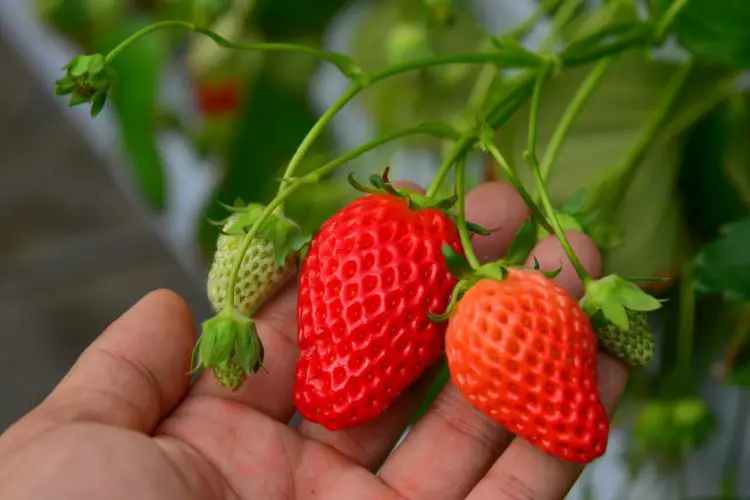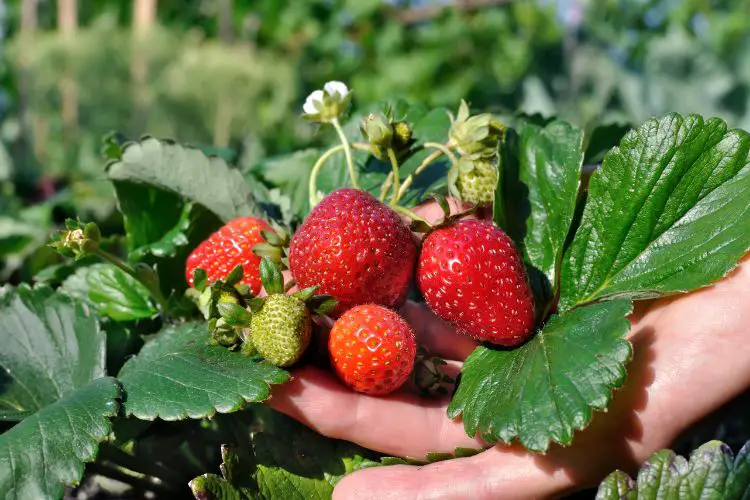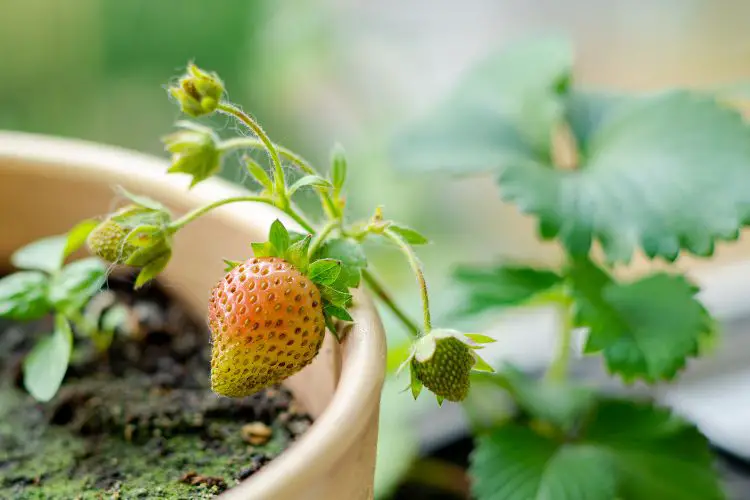Learn how to grow your own delicious strawberries with this comprehensive guide! Whether you’re a beginner or experienced gardener, this article will equip you with the knowledge and skills needed to cultivate your own bountiful strawberry garden. From choosing the right variety to tackling potential challenges, you’ll find everything you need to know to successfully grow sweet, juicy strawberries at home.

Introduction to Growing Strawberries
Are you a fan of sweet, juicy strawberries? Imagine being able to step into your own garden and pluck fresh, delicious strawberries whenever you desire. With the right knowledge and skills, you can cultivate your own bountiful strawberry garden right at home. Whether you’re a beginner or an experienced gardener, this comprehensive guide will equip you with everything you need to know to successfully grow your own strawberries.
Benefits of Growing Strawberries at Home
Growing strawberries at home offers numerous benefits. Not only do homegrown strawberries taste far better than store-bought ones, but they also allow you to avoid harmful pesticides and chemicals. Additionally, cultivating your own strawberries can be a rewarding and cost-effective way to enjoy this delectable fruit throughout the growing season.
Overview of the Growing Process
The process of growing strawberries involves selecting the right variety, preparing the garden, planting the strawberries, caring for the plants, managing runners, harvesting the berries, and troubleshooting any potential challenges that may arise. By following the steps outlined in this guide, you’ll be well on your way to enjoying a plentiful harvest of sweet, succulent strawberries.
Choosing the Right Strawberry Variety
Before you start your strawberry garden, it’s essential to choose the right variety that suits your gardening needs and preferences.
Factors to Consider When Selecting a Strawberry Variety
When selecting a strawberry variety, consider factors such as your local climate, the size of the berries, the flavor profile, and the plant’s resistance to diseases and pests.
Popular Strawberry Varieties for Home Gardens
Some popular strawberry varieties for home gardens include ‘Albion,’ ‘Seascape,’ ‘Eversweet,’ and ‘Tristar.’ These varieties are known for their excellent flavor, high yield, and adaptability to various growing conditions.
Preparing the Garden for Strawberries
To ensure the success of your strawberry garden, it’s crucial to prepare the garden and soil properly.
Selecting the Ideal Location for Your Strawberry Garden
Choose a location that receives morning sun and afternoon shade, as this will provide the strawberries with the optimal amount of sunlight while protecting them from the harsh afternoon heat.
Preparing the Soil for Planting Strawberries
Strawberries thrive in well-draining, slightly acidic soil. Before planting, ensure that the soil is rich in organic matter and free from any weeds or debris.
Tips for Raised Bed Strawberry Gardening
If you’re short on space or dealing with poor soil quality, consider planting your strawberries in raised beds. This method allows for better soil control and drainage, resulting in healthier plants and a more abundant harvest.
Planting Strawberries
Once you’ve selected the right variety and prepared the garden, it’s time to plant your strawberry plants.
Best Time to Plant Strawberries
The best time to plant strawberries is in the early spring, as soon as the soil is workable and the danger of frost has passed. It is important to choose a sunny location with well-drained soil for optimal growth. Prior to planting, it is recommended to prepare the soil by incorporating organic matter and fertilizer. Plant the strawberries in rows, with plenty of space between each plant for air circulation. Water the plants regularly, especially during dry periods, and mulch around the plants to help retain moisture and suppress weeds. With proper care, you can enjoy a bountiful strawberry harvest in the summer months.
Proper Spacing and Depth for Planting Strawberry Plants

When planting strawberry plants, ensure that they are spaced about 12-18 inches apart, with the crown of the plant level with the soil surface. This spacing allows the plants to receive adequate airflow and sunlight, promoting healthy growth.
Caring for Newly Planted Strawberries
After planting, provide the newly planted strawberries with ample water and a balanced fertilizer to encourage strong root development and vigorous growth.
Caring for Strawberry Plants
To ensure the health and productivity of your strawberry plants, proper care is essential.
Watering and Fertilizing Strawberry Plants
Consistent watering is crucial for strawberry plants, especially during the fruiting season. Additionally, fertilize the plants with a balanced fertilizer to provide them with the essential nutrients they need to produce healthy berries.
Mulching to Maintain Soil Moisture and Suppress Weeds
Applying a layer of mulch around the strawberry plants helps retain soil moisture, regulate soil temperature, and prevent weed growth, ultimately promoting the plants’ overall health and productivity.
Controlling Pests and Diseases in Strawberry Plants
Keep an eye out for common pests such as adult vine weevils and diseases like anthracnose fruit rot. Implementing proactive measures, such as regular inspections and the use of organic pest control methods, can help prevent and manage these issues effectively.
Pruning and Runner Management
Proper pruning and runner management are essential for maintaining the health and productivity of your strawberry plants.
Importance of Pruning and Managing Runners
Pruning helps remove old, diseased, or overcrowded foliage, while managing runners prevents the plants from becoming too dense, ultimately promoting better airflow and fruit production.
Techniques for Pruning and Managing Strawberry Runners
Regularly remove excess runners and older leaves, and trim the runners that you wish to propagate to ensure that the plants remain healthy and productive.
Harvesting and Storing Strawberries

As the growing season progresses, it’s important to know when and how to harvest and store your ripe strawberries.
Determining the Right Time to Harvest Strawberries
Harvest your strawberries when they are fully red, plump, and ripe. Avoid picking them when they are still white or partially red, as they will not continue to ripen after being picked.
Proper Techniques for Picking Strawberries
Gently pick the ripe strawberries, making sure to leave the stem and cap intact. This method helps preserve the berries’ freshness and flavor.
Tips for Storing and Preserving Freshly Harvested Strawberries
Store freshly harvested strawberries in the refrigerator and consume them within a few days for the best flavor and quality. You can also freeze or preserve the berries to enjoy them throughout the year.
Troubleshooting Common Strawberry Growing Challenges
Despite your best efforts, you may encounter some common challenges when growing strawberries. It’s essential to be able to identify and address these issues promptly.
Identifying and Addressing Common Issues with Strawberry Plants
Keep an eye out for issues such as yellowing leaves, moldy berries, or stunted growth, and take appropriate measures to address these problems before they escalate.
Preventing and Managing Pests and Diseases in Strawberry Gardens
Implement preventive measures such as proper sanitation, regular inspections, and the use of disease-resistant varieties to minimize the risk of pests and diseases in your strawberry garden.
FAQ
Can you grow strawberries by seed ?
To grow strawberries from seed, start by choosing a high-quality strawberry variety that is well-suited to your climate and soil conditions. Next, prepare a well-draining potting mix and sow the seeds in small containers, covering them lightly with soil. Keep the soil consistently moist and place the containers in a warm, sunny location. Once the seedlings have grown a few inches tall, transplant them into larger containers or directly into the garden, ensuring they have enough space to spread out. Regularly water and feed the plants, and protect them from pests and diseases. With proper care, you can enjoy a bountiful harvest of delicious homegrown strawberries.
How to grow strawberries bigger ?
To cultivate larger strawberries, it is essential to implement proper care and maintenance strategies. Start by selecting a suitable site with well-drained soil and ample sunlight. Consider incorporating organic matter into the soil to improve its fertility and structure. Plant the strawberries at the correct depth, ensuring that the crowns are above the soil line. Adequately water the plants, especially during dry spells, and use mulch to conserve moisture and suppress weed growth. Regularly feed the strawberries with a balanced fertilizer to promote robust growth and fruit development. Additionally, protect the plants from pests and diseases by practicing good garden hygiene and promptly addressing any issues that arise. Lastly, harvest the strawberries when they are fully ripe to enjoy the best flavor and size. By following these guidelines, you can increase the size of your homegrown strawberries and enjoy a bountiful harvest.
When to plant dormant strawberries ?
Determining the best time to plant dormant strawberries depends on the climate in your region. In general, dormant strawberries should be planted in early spring, as soon as the soil is workable and there is no longer a risk of hard frost. However, in cooler climates, it may be better to plant dormant strawberries in late summer or early fall to allow the plants to establish their root systems before winter. Be sure to research the specific needs of the strawberry variety you are planting and consider local climate conditions to determine the most suitable time for planting.
How to grow strawberries quickly ?
There are several key steps you can take to expedite the process. First, make sure your strawberry plants are getting plenty of sunlight, ideally around 6-8 hours per day. Additionally, ensure that the soil is well-draining and rich in organic matter to promote healthy growth. Regular watering is essential, especially during the fruiting stage, but be sure not to overwater to avoid root rot. Consider using a balanced fertilizer to provide the necessary nutrients for optimal growth. Finally, regularly remove any weeds and dead leaves to allow the plants to focus their energy on fruit production. By following these tips, you can help your strawberries reach maturity more quickly.
How to grow strawberries from stem ?
If you want to grow strawberries from a stem, there are several simple steps you can follow. First, select a healthy strawberry plant with strong, disease-free stems. Then, using sharp, clean scissors, snip off a few inches of a runner (horizontal stem) that has a baby plantlet attached to it. Next, gently press the stem into the soil in a pot or garden bed, making sure the baby plantlet is in contact with the soil. Keep the soil consistently moist and place the plant in a sunny spot. Soon enough, the baby plantlet will take root and start growing into a new strawberry plant. With proper care and attention, you can enjoy a bountiful harvest of fresh, homegrown strawberries from your stem-grown plants.
What to plant with strawberries in container ?
When planting strawberries in a container, it is important to consider companion plants that can enhance their growth and protect them from pests. Some suitable companion plants for strawberries in containers include herbs like thyme, oregano, and sage, which can help repel pests and attract beneficial insects. Additionally, planting borage or marigolds alongside strawberries can also help to deter pests and attract pollinators. These companion plants not only provide natural pest control and pollination support but also add visual interest to your container garden. By incorporating these companion plants, you can create a thriving and diverse ecosystem within your strawberry container garden.
When do plants produce strawberries?
Plants produce strawberries during the fruiting season, typically in the spring and summer months. Strawberries are the product of the flowering and pollination process, which takes place after the plant has received an adequate amount of sunlight and water. The formation of strawberries begins with the development of the flower into a fruit, followed by the maturation process. Once ripe, the strawberries can be harvested for consumption.
Conclusion
Growing your own strawberries can be a fulfilling and rewarding experience. By following the comprehensive guide provided, you now have the knowledge and skills needed to successfully cultivate your own bountiful strawberry garden. Whether you choose to grow strawberries in your backyard, window boxes, or hanging baskets, the joy of harvesting and enjoying your homegrown berries is truly unmatched. So, what are you waiting for? Start your own strawberry garden and savor the sweet, juicy fruits of your labor.
